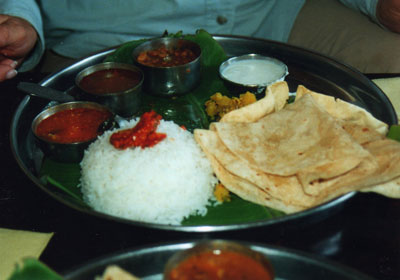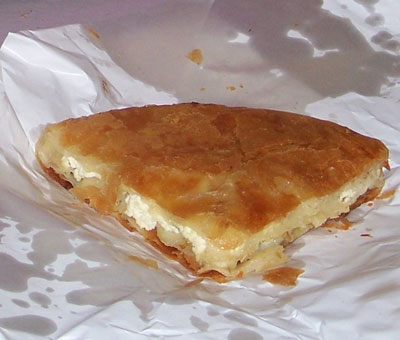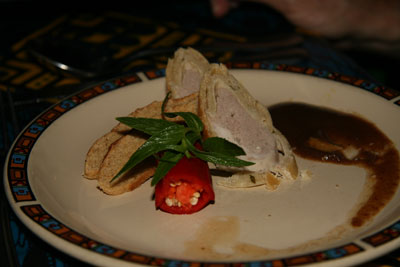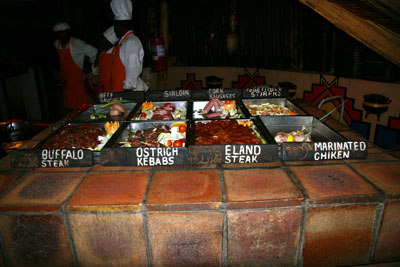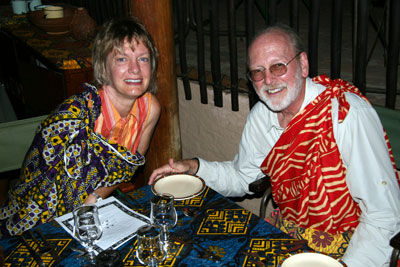What to eat where
Ellen Jacobson of Centennial, Colorado, wrote, “I would like readers to write in about the good food experiences that others can expect to have in different countries. I’m not talking about specific restaurant recommendations but about the particular dishes or types of foods that travelers should seek out in new places.”
Ellen’s suggestion was fresh seafood in Borneo; specifically, look for restaurants with saltwater tanks. And we tossed up some specific questions for our readers to answer: “What is a sure-fire meal, dish, food or snack in another country (outside the US) that YOU suggest we sample? Tell us about it plus how to find it and what to ask for. Include approximately when you last tried it plus, if you can, how much it might cost. If you do mention a specific restaurant, add contact info and/or give an approximate location.”
Several responses are printed below, but we’re sure more will come in. Send them to What to Eat Where, c/o ITN, 2116 28th St., Sacramento, CA 95818, or e-mail editor@intltravelnews.com (include the address at which you receive ITN).
During our travels in southern INDIA in January ’08, we became familiar with the meal called thali, served in nearly all restaurants. (It’s also served in northern India.) Thali, a selection of dishes, is often served on a round steel plate with the individual dishes in small bowls or on plantain leaves.
In addition to delicacies native to the region you’re visiting, typical dishes include rice, dal (lentils), vegetables, chapati, pappadum (crisp, thin crackers), yogurt, small amounts of chutney or pickle and something sweet. All this for about $1 (150-250 rupees)!
This, indeed, was a daily banquet and a way to become familiar with Indian food.
Lorna Tjaden
New Hope, MN
One of my favorite dishes, served really fresh on CROATIA’s Adriatic coast, is lignje. Lignje is calamari, and the most delicious version is grilled with a coating of olive oil and garlic. A dish of lignje cost $ 7-$10 in July ’09.
• In the western BALKANs, ćevapi is their version of our hamburger. It is made from minced meat, usually veal, which has been marinated in delectable spices. The mixture is formed into small brickettes and grilled. It is served on round bread, more flavorful than our hamburger bun, along with chopped scallions.
A dish of ćevapi costs about $7.
Burek are savory tarts or pastries found in many western Balkan countries. They are made of phyllo pastry or flaky puff pastry dough and generally are filled with cheese (most commonly feta), ground meat or vegetables (most commonly spinach). They come in the twisted variety or as tarts.
Deanna Palić
Contributing Editor
Do not miss the fresh-squeezed orange juice in the Tozeur area of TUNISIA. Blood oranges are used, and it’s absolutely the best OJ in the world! It cost $1 per glass in April ’09.
• Try almost anything in the tapas bars in the old section of San Sebastián in northern SPAIN. $2-$4 per serving in 2000.
Try sidra (hard apple cider) in the Galician region of Spain. $3 per glass.
• There’s lime curd in SCOTLAND. I found it at $5 per jar in May ’08, but the best is homemade.
• Savor oak-smoked salmon in IRELAND. The best is in the pubs.
• Green-lipped mussels in NEW ZEALAND cost $5 per serving in 2001.
• I also enjoyed grilled barramundi in Cairns, AUSTRALIA.
Linda Crain
Signal Hill, CA
My world travels began in 1957 and I have never stopped. I’ve been to all seven continents. Over the years, I have become a “street food” junkie. Street food is the signature of a culture and, in the free spirit of adventure, finding it is the easiest way to really get acquainted with the people and the energy of a place.
• In 1992 and ’93 I was living in KOREA, working on their EXPO ’93 in Daejeon. The street food in Korea was wonderful. Kimchi was available everywhere.
On an excursion to see the fall colors, I rode back to Seoul in a train that was packed to the doors with people. Although my Korean was limited, the other standees and I shared stories and talk of the day. Soon someone unwrapped a package of dried squid, aka “Korean chewing gum.” It was passed around and we all wound up gnawing on the tasty snack.
One lesson I learned in Korea was how to know which mom-and-pop restaurant was good and which one was to be given a pass. If mama was sitting at the cash register, I would go in and the food would be very good. If papa was sitting at the cash register, I gave the place a pass. That piece of wisdom served me well.
• In 1994 I started working in Istanbul, TURKEY. The project wound up in 1996, but I returned to Turkey nearly every year through 2002. In 2005 I went back again with my wife, who had been there before, and mother-in-law (a delayed 80th birthday gift).
My wife had us head for the nearest fish restaurant serving bluefish, but my favorite street food there was the giant, fresh-baked potatoes that were presented to be topped with almost every imaginable filling.
The best place in Istanbul for these super baked potatoes was along the Bosporus in the Bes¸iktas¸/Bebek area. Each stand had its own wood-fired baking oven and a lighted case displaying all of the available fillings, usually 20 or more. The vendor would open the potato and, with a flair and gusto, blend in the selected fillings.
The finished “meal” was served up steaming in a paper bowl with a plastic fork and napkin. The cost for this repast was around $5.
• In December ’05 I was in Ushuaia, ARGENTINA, getting ready to embark on a cruise to Antarctica. About four or five blocks up into town from the Lennox Hotel on Avenue San Martín, on the right side of a small arcade there was a very small and unpretentious, glass-fronted restaurant serving gaucho-style grilled meat. It had a wood-fired grilling pit in the front window with iron pikes loaded with all sorts of wonderful meat.
For the equivalent of $7.50 I enjoyed the all-you-can-eat appetizer buffet and all-you-can-eat meat plus a beer and dessert.
The meat was aromatic, juicy and tender. There was beef of several cuts plus lamb, chicken and sausage. I asked the grill-tender for a small slice of beef and what I got nearly covered the plate. The lamb was spectacular.
What a great way to get ready for an Antarctic adventure! The food was so good at this little nontouristy restaurant, I had dinner there the night I returned from my 10-day shipboard adventure.
David Collins
Newbury Park, CA
In CURAÇAO in the southern Caribbean, goat stew is served at restaurants catering to the locals; you’re not likely to find it at the resort dining places. When I had it for lunch a few years ago, it cost about $7.
There are lots of goats on Curaçao and they roam and graze freely, requiring some attention when driving on the back roads.
• In Cornwall, ENGLAND, the best pasties are made in shops on the “high streets” in the larger towns. I ate them a couple of times a week during a three-week trip in 2007. The good ones cost about $5.
Kent Shamblin
Beaver Bay, MN
When in Jerusalem, ISRAEL, be sure to visit the Jewish Market. The falafel sandwiches there are not only inexpensive but out-of-this-world delicious. The stands keep several dishes of condiments on the counter for you to add as much as you want. Our favorite was the eggplant salad.
Know that they will stuff French fries into the sandwich unless you stop them. Two sandwiches with beer and soft drink came to less than $10 in January ’09.
While in the market, look for breads each shaped in an oval, like a toy railroad track, with sesame seeds on top. They are delicious and great to eat just by themselves. They cost $1 to $2 each and stayed fresh for more than one day.
Besides bread, the deli stands offer a wonderful variety of salads and other picnic fare.
The market is right by the downtown area. I wish we had found it earlier in our visit, since we liked its offerings far better than the more expensive but uninspiring meals we ate. It also was interesting to people-watch in the market and see how the locals live.
We had no trouble getting to and from the market by taxi.
• In EGYPT, look for nut stands. For some reason, their peanuts tasted better than any other peanuts I’ve had (January ’09). There were nut stands in the Jewish Market in Jerusalem, too, with excellent nuts.
Nancy Tan
Fresno CA
Having visited 156 countries in a lifetime of travel and eaten thousands of meals overseas, there is only one that frequently pops into my mind and that was in Quito, ECUADOR, about 10 years ago. It was in a restaurant next door to the jeweler H. Stern.
We had the locro de papa, a potato soup with avocado floating in it — a national dish — plus a delectable roast chicken just a touch different than any at home and, for dessert, the world’s best coconut cream pie.
I never think of any other meal in any country I have visited but often feel the need to tell tablemates about this particular meal. I almost drool just thinking about it.
Muriel Dowe
Fort Worth, TX
We enjoyed the food on Crete during our trip to GREECE in 2003. In Heraklion, the restaurant Loukoulos (Korai 5; phone 2810 224 435, fax 2810 285 525, www.loukoulos-restaurant.gr) was on one of the pedestrian-only streets, so we were happy to dine on the outdoor terrace listening to opera with no traffic noise.
We had a liter of Cretan wine, veal and dried figs in wine sauce plus lamb steaks and, for dessert, loukoumades, which are fritters with honey syrup, all for about $38 for two.
The Alana Restaurant (Salaminos 15, Rethymnon Old Town, Crete; phone +30 28310 27737 or mobile +30 69483 74330, www.alana-restaurant.gr), with a pleasant outdoor eating area, had a menu section featuring Cretan specialties.
Rabbit stew, goat with artichokes, wine and cake were the specialties we ordered, but also served to us as part of the “cover” were a yogurt salad, chopped olives, lovely bread and, at the end of the meal, a carafe of raki. The cost for this lovely meal was about $44.
Crete is famous for olives, olive oil, snails (fried or sometimes cooked with stone-ground wheat or bulgur), cheese, cheese pastries and baked barley goods.
Dakos, thick slices of crusty bread topped with drained grated tomatoes, feta cheese, oregano and olive oil, comprise a traditional light meal, and another specialty is xerotigana, or honey-dipped, fried spiral pastries.
Nell McCombs
Ventura, CA
Adjacent to the Victoria Falls Safari Lodge complex in ZIMBABWE, The Boma (www.thebomarestaurant.com) is a restaurant situated in the Gusu Forest. On Sept. 10, 2009, our private guide, Darryl Tiran, arranged seating for the three of us in a quiet alcove.
The evening began with everyone receiving an African print cloth to wear over their shoulders. With 220 people waiting in line to enter the restaurant, this took some time.
My wife Lorelyn, began with ikhekhe lenyamazana, which was ostrich-and-guinea-fowl paté wrapped in wild spinach pastry and served with a local wine-infused date puree.
I opted for umthombo we nhlanzi ze zambezi, or smoked crocodile and sun-dried peppered river breem fillets with home-preserved lemon and tomato onion salsa.
After three courses, the main buffet entrées included ostrich kebab, kudu, eland steak, buffalo steak, impala stew, croc stir-fry and butterflied lamb on a spit.
The buffet area also featured “eat a mopani worm.” The mopani worm is the brightly colored caterpillar of the large emperor moth. It’s cooked to a crisp and contains three times the protein of beef. Locals eat them as snacks. They were crunchy and quite spicy, but the worms, themselves, do not have much flavor.
The number of tour buses in the parking lot indicated The Boma would be “touristy,” but, to their credit, it was a well-planned and interesting experience. The price per person was about $35.
Fred Koehler
Orange, CA
After traveling for more than 40 years and visiting more than twice that many countries, it is difficult to pinpoint the most special meals. I start to salivate just remembering all of them!
A January ’09 revisit to SRI LANKA meant several fabulous breakfast buffets at the Unawatuna Beach Resort (Unawatuna, Galle, Sri Lanka; phone +94 91 5 626 100 or 91 4 384 545, fax 91 2 232 247, www.unawatunabeachresort.com) and eating as many string hoppers (idiyappam, or indiappa) with fish curry as we could! The string hoppers are like vermicelli pancakes and act like tortillas for the fish curry made of firm white fish in a spicy sauce. Yum!
The fabulous buffet cost under $10 and included a variety of Sri Lankan dishes, fruits, eggs of any kind and several meats and pastries.
Judie Kesson
Coronado, CA
Regarding dining, my eyes were opened on my first visit to Singapore when I went to an outside food court, with runners bringing various dishes to my table for small tips. I was the only Westerner there and it was great fun.
In any country, two things are musts, for me, for some meals.
First, I always seek out the local family restaurants that feature comfort foods. They will be nothing like fine dining or hotel meals, but, inevitably, they will be delicious and will reveal a side of the region that can’t be found elsewhere.
My second choice is to sample meals from LOCAL fast-food chains, avoiding all Western chains. Flunch (www.flunch.fr) in FRANCE and Jollibee (www.jollibee.com.ph) in the PHILIPPINES are two examples.
Dr. Norbert Brockman
San Antonio, TX
I discovered an absolutely delicious fruit drink on a tour through the United Arab Emirates in October ’09. I found the drink at the Forty Fruity (www.fortyfruity.ae) juice stalls, located in a couple of the large malls.
What’s different is, in addition to smoothies, they do some thick and creamy “stacked” juices in a glass. I particularly liked the “Casablanca,” which was avocado, then mango and, on top, coconut, which not only was delicious when you stuck your straw in at each different level but was so pretty to look at.
I have asked at juice chain stores and mom-and-pop shops here at home, but none do drinks like that. Perhaps someone has seen such drinks in the States. I sure thought they were special.
Hilary Walling
San Diego, CA

